Beatrijs and Elckerlijc in the time machine
Max Reinhardt as unwitting cultural mediator of medieval Dutch literature
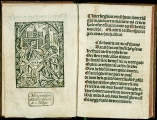
The two gems of medieval Netherlandish literature, the Elckerlijc, a morality tale written around 1500, and the early fourteenth-century legend of the Virgin Mary, the Beatrijs, were not translated into Hungarian until the early twenty-first century. Both stories were nevertheless widely known and popular in Hungary in the first half of the twentieth century, despite the fact that the Dutch texts themselves were unknown. How can this phenomenon be explained?
The circulation of old stories

What Elckerlijc and Beatrijs have in common is that they both retell an older story, a popular theme that appears in many European languages and even in non-European literatures. These stories, which spread like 'recorded folklore' in the words of Aleida Assmann, are characterised by the unknown author, openness, and variability of form, which also give the authors and adapters of the stories a great deal of freedom. From the complex web of reception history of the Elckerlijc and Beatrijs, it is worth highlighting one literary and cultural mediator, Max Reinhardt (1873-1943), one of the most influential theatre directors of the twentieth century, who unwittingly played the most significant role in the recognition and dissemination of both works in Hungary. #Mediators
Max Reinhardt and two blockbuster productions in Europe
In December 1911, two new productions by Max Reinhardt were opened to the public. On 1 December, the premiere of Hugo von Hofmannsthal's Jedermann: Das Spiel vom Sterben des reichen Mannes took place in Berlin. Three weeks later, the pantomime Das Mirakel - The Miracle by Karl Gustav Vollmoeller was performed in London. The two plays later became legendary in the theatre genius's oeuvre and brought him not only worldwide fame but also enormous financial gain. Moreover, by looking at the steps of adaptation and translation the wthat led to the productions, both can be traced back to now canonical works of medieval Dutch, the Elckerlijk and the Beatrijs respectively.
Reinhardt, born in Austria had strong links with Hungary early in his life. Immediately after the premiere of Jedermann in Berlin, Reinhardt took the play to Budapest in 1912. The production was included in the programme of the Salzburger Festspiele from 1920. Reinhardt also engaged Hungarian actors, such as Lili Darvas, for certain performances of the play. Miklós Kállay prepared a Hungarian translation of Jedermann in verse form in 1924, and the play was regularly performed in Hungarian from then on, for example between 1934 and 1938 on Margaret Island in open-air performances. In addition to stage performances, it was also very popular as a radio broadcast.

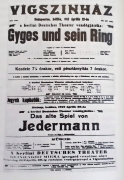
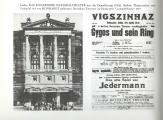

The early reception of Das Mirakel in Hungary was similar. The play that was used as a source by Volmoeller for the script of Das Mirakel was Soeur Béatrice, originally a libretto written in 1901 by Maurice Maeterlinck. The French and Dutch-speaking Belgian author, who also won the Nobel Prize based his play on the Middle Dutch of Beatrijs. Maeterlinck’s play was published in Hungarian in May 1912. It was translated by Sándor Hevesi under the title Beatrix nővér [Sister Beatrix]. Reinhardt hired Hungarian actors for Das Mirakel, who received considerable attention in the Hungarian press. After the London premiere, the two title roles were played by Ernő Mátray and Sári Fedák at the first continental premiere of the play in Vienna. Das Mirakel as a play was first staged in Hungary in 1927. His film adaptation of a similar title (1912), which was seen by an estimated 12-15 million people across Europe, was also shown in Hungary.
Differences in the long-term reception in Hungary
Both plays, based on the Dutch medieval literary works were very popular in the beginning of the 20th century in Hungary. However, looking at the two cases, we can discover a significant difference in the long-term reception of the works. The Beatrijs adaptation Das Mirakel has by now virtually disappeared from the Hungarian literary consciousness. Hevesi's translation of 1912 is apparently not even known in modern literary history since the work was translated again in 1999 by János Lackfi under the title Sister Beatrice not even mentioning the previous translation. By the beginning of the 21st century, the story of the nun Beatrijs had fallen into oblivion in Hungary, and only occasionally is there any mention of her story, for example in Veronika Sinkó's religious-didactic picture book The Legend of Mary for Children (2011).
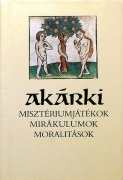
In contrast, the Jedermann/Everyman/Elckerlijc story has become deeply rooted in Hungarian culture. Sixty years after Miklós Kállay's translation, the Hungarian translation of the Middle English Everyman by Gyula Tellér was published in 1984 under the title Akárki [Anybody]. Péter Kárpáti wrote a highly successful adaptation of the play in 1993, retaining the title Akárki. After the success of Kárpáti's adaptation, directed by Gábor Zsámbéki at the Katona József Theatre in Budapest, the play was translated into English. The story of Elckerlijc has been the subject of literary reinterpretation for a new generation of writers and poets, such as Szilárd Borbély, László Garaczi, Borbála Szabó, István Tasnádi, Katalin Thuróczy, Borbála Szabó and others, addressing actual existential questions in highly innovative literary forms. This morality is regularly performed in Hungarian theatres and puppet theatres up to the present time.
Two modern collective translations: a new beginning?
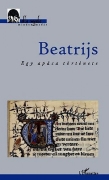
The Hungarian translation of the Middle Dutch Beatrijs was published in Hungarian in 2012, translated by Zsuzsa Rakovszky in the framework of a collective translation project. The Hungarian poet’s verse translation was based on the prose text prepared in a literary translation seminar in which teachers and students of Dutch Studies at the Eötvös Loránd University (ELTE) and the Károli Gáspár Protestant University (KGRE) cooperated. This was the first publication in the series olla vogala / minden madár, Old Netherlandish Literature edited by Anikó Daróczi and Orsolya Réthelyi. A similar workshop resulted in a Hungarian translation of the Elckerlijc (to be published in 2023), translated by poet Anna T. Szabó, also in this case as a collective translation project. The publication of the Hungarian translation of Beatrijs and Elckerlijc opens a new chapter in the Hungarian reception of these important works of the Dutch literary canon.
(Orsolya Réthelyi)
